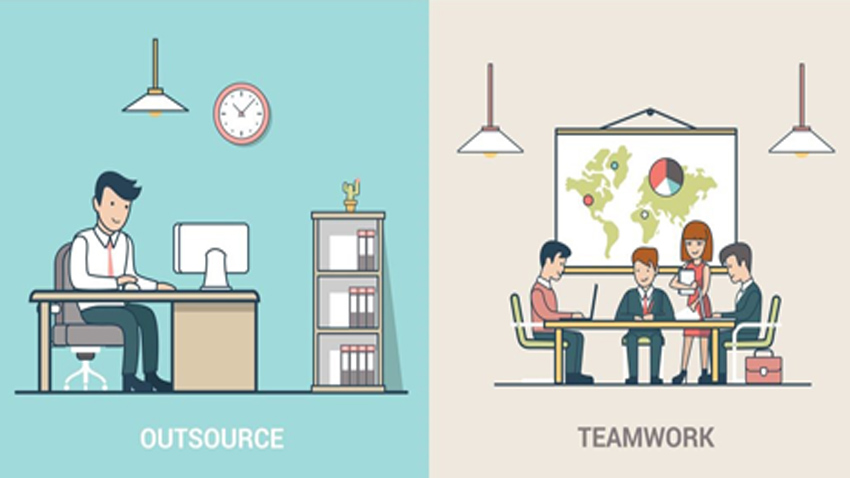Kirill Tatarinov, the CEO of Citrix Systems, recently spoke on Marketwatch.com about the future of the work force; saying that by 2020, 50% of the workforce will most likely be working remotely. He went on to say that today’s professionals (executives, entrepreneurs, and many knowledge workers) are already highly mobile.
The list of companies moving towards a remote workforce model is growing, as many businesses realize the benefits of using a remote workforce. Companies like Citrix, SkillCrush, TELUS, and many more, have already moved to a highly flexible remote model for their employees, but if you think it’s something only large corporations can do, you should read on.
The Benefits of a Remote Workforce
The Huffington Post recently made a list of the “Top 10 Benefits of having remote workers on staff.” The benefits for the hiring company were quite enticing. Some of those benefits were lower cost of overhead in regards to workers, equipment, and work space (since workers own their own equipment and work from home), lower turnover (due to happier employees), lower real estate costs, and a smaller corporate environmental footprint among many others.
Even something as simple as avoiding driving in the harsh Canadian winters was counted as a benefit (I know a lot of people who would love to skip out on that particular aspect of their commute).
Another of the benefits of building a remote workforce is the amazing culture it can bring. In an environment where people are trusted and have full responsibility for their output, they tend to take better ownership of their responsibilities (or see the immediate results of a lack thereof).
In a world where employee loyalty seems to be declining, there have been numerous studies (including this recent – incredibly interesting – study from the Harvard Business Review) that show how employees are more loyal to companies that show trust in their ability to provide the valuable service they were hired for.
Employee’s that are trusted feel like their work has a greater impact on the company as a whole; which is something almost every study has shown immensely increases employee satisfaction. Providing them with the option to work when and where they feel the most productive can increase their work accomplished, their company loyalty, and their overall happiness.
As Billionaire Richard Branson says, “Clients do not come first. Employees come first. If you take care of your employees, they will take care of the clients.”
But, if you’re reading this article, then you most likely don’t have to be sold on the benefits of a remote workforce. Instead, you’re probably searching for practical ways to implement your own remote workforce.
Best practices for managing a remote workforce
Setting up an effective remote workforce (one that has the flexibility you want but also provides the results you need as a business) is easier than it may seem.
It simply requires that you prioritise effective methods of communication as well as clearly define the standards, goals, and expectations for your team.
One of the biggest fears employers have (when considering a move towards a remote workforce) is ensuring that productivity will continue. You may wonder, “If we let everyone work from where they want, will we find ourselves paying our employees to sit at home and play solitaire or clean their living rooms”? “How can we ensure that we are getting back the value we are paying our employees for”?
Remote.co (a website dedicated to helping companies grow remotely) recently featured a question on this topic. They asked leading companies, with primarily remote workforces, how they keep their remote employees engaged; many businesses responded with great ideas and tips.
Some examples are:
- Having a clear mission and clearly defined goals.
- Regular check-in times as a team (to foster bonds of friendship and camaraderie as well as update everyone on your progress as an organisation).
- Making sure all employees understand the company’s strategy and core beliefs (to understand the “why” and also to have a clear vision of the goal that you, as a team, are trying to achieve).
Both Simon Sinek (famed author, entrepreneur, and marketer) and Jocko Willink (a retired Navy Seal Commander, author, and business consultant) have incredibly poignant remarks about this point.
Simon Sinek says (in his book “Start with Why”), “people don’t buy what you do; they buy why you do it.” This is true not just for your customers, but your employee’s as well.
When your employees understand the “whys,” both the company’s “why” and their own, they will transfer that passion and energy into their work, into their dealings with customers, and into their commitment to the company. They will no longer be working just because they get a pay cheque, rather, they’ll do it because they are determined to see the company succeed.
Jocko Willink often speaks about the idea of letting your team in on as much information as you can about their mission (in this case it’s the goal of what your team, or company, is working to achieve).
In his best-selling book “Extreme Ownership,” Willink speaks about setting clear goals and clear instructions for your subordinates. If they don’t understand the mission, and their role in it, they won’t be able to execute it effectively. It’s up to the leaders to make sure everyone on their team is aware of the overall mission of the organisation as well as their particular role in it – if they don’t, it’s not their fault if they fail. As Willink says, “There are no bad teams, only bad leaders.”
So, especially in a remote working environment, it’s extremely important to make sure each person is aware of the mission, their part in completing that mission, and that they are able to communicate efficiently with their co-workers as well as “up the chain of command.”
Inc.com got into even greater detail, on how to effectively manage a remote team, with a great article titled “6 Ways to Keep Your Remote Workers Engaged and Productive,” it gives six excellent tips on how to manage your workforce and keep them engaged and producing like never before.
- Make activity tracking automatic (don’t rely on self-reported data, have systems in place to automatically track and report the data you need.)
- Focus on what, not when (don’t worry about what time of day your team is working, focus on ensuring achievement and productivity)
- Make sure everyone knows they are part of the team (keep your team in the loop about the company’s goals and any changes that arise)
- Establish a time and method for regular check-ins (set up systems and processes so everyone knows when they will be able to have access to you or other members of the management team).
- Get to know your remote employees as people (This can be difficult with “remote only” employees, though many remote workforces have a more hybrid setup which makes it easier to get to know each employee, in cases where your team is completely remote, you can still get to know who they are as people, it takes effort but it’s worth it!)
- Schedule regular face-to-face time (in this case Apple’s Face Time app doesn’t count)
You may have noticed one underlying theme that runs through every article and testimonial we’ve mentioned so far –communication!
Good communication is integral to an effective remote workforce; both in the interpersonal sense and in regards to communications technology.
(For practical ways to implement these six steps check out this great article from Business.com “11 Tools for Tracking Your Remote Staff’s Productivity”)
The technology you need for your remote workforce:
There are a lot of different platforms like Slack, Trello, or Skype that can help with one aspect or another of keeping your remote team connected.
What many people don’t know, however, is that you most likely have most of (if not all) the tools to connect your team already in place. Or, if not, you can very easily get everything you would need to connect your team on one platform from an often overlooked source – your business telephone system.
We wrote a blog article (5 Ways to Keep Your Remote Workforce Connected) with some great information about the options available, through IP telephones, for companies setting up a remote workforce. But today we are going to go a little more in-depth about all the pieces that you can put in place for the full range of communication options to successfully operate in a remote environment, and not just operate, thrive.
Here are the features you can get through your phone system that will help keep your workforce engaged, connected (with you and each other), and operating at optimum capacity.
Phones:
Whether it’s a cell phone with “find-me/follow-me” enabled, an employee’s home phone, or a soft phone set up right on their computer, your phone system can easily be set up with remote users in mind.
Often people will say you need to have a “hosted” phone system to be able to connect your remote workers, but that’s not necessarily the case.
The only thing you need to be sure of when setting up your phone system is that it is an IP phone system (you can learn more about the difference between traditional and IP phone systems in this beginners guide to IP phone systems). If you’re wondering if it needs to be a hosted (cloud-based) system or an on premise system, don’t worry about it yet. Having a hosted or premises based system doesn’t affect your ability to deploy it for a remote workforce.
Once you have your IP system set up, you now have the option to set up your remote workers in any of these four ways:
- Deskphone option – you can easily have a phone set up at your remote worker’s location, the nice thing about this particular option is that it allows all the VPN tunneling and MAC registration to be pre-set on the phone and once it arrives all you’ll have to do is plug it in and it will automatically register (securely) back to your system.
- Find-me/Follow-me – This is more like option “1.b” because it works easily with the above mentioned deskphone (whether at the remote location or the main office), it is especially effective if your remote workers will be in and out of a central office (e.g. sales teams).The “find-me/follow-me” option allows quick and easy routing of calls from your office phone to a home phone or cell phone. Whether calling out, or receiving a call, you will be utilising your business phone number and voicemail box, allowing you to keep your work and private lives separate.With this option clients will be able to reach you, no matter where you are, with the same phone number they would use to reach you at your desk.Of course you can change the setting if you don’t want to be reached at or after certain times, each employee will be able to enable or disable the “find-me/follow-me” option as needed.
While the “find-me/follow-me” option is best implemented with a desk phone, it technically does not require a desk phone. For example, as long as the user has an extension set up for them through the phone system they can set the “find-me/follow-me” rules to ring their mobile phone automatically, removing the need for a desk phone. Rules can also be set so that, after a certain number of rings, the call is automatically sent to the remote workers business voicemail box. - Mobile phone option – Most business phone system providers offer a mobile application that can be installed on the user’s smartphone; this would allow them to use their smartphone to perform all the activities they usually would on their desktop phones.
Whether your company has a “bring your own device” policy, or would prefer to provide a pre loaded device (with the mobility app), this option gives the truest form of ‘mobility’ for your mobile or remote workers. They essentially have their office phone (and its capabilities) in their pocket – an office anywhere!There is a caveat, when using a mobile app your calls will either be routed through your business phone system (you place a call via the mobile application and the system calls you back to connect your call through your office telephone system) or you can call directly using WiFi or Data. The latter option becomes incredibly useful for avoiding roaming and long distance charges when doing business out of town, simply connect to your hotel, restaurant, or the airport WiFi and your remote office is up and running including: presence, access to voicemail, contacts, and free calling. - The Soft Phone option – A soft phone is an app that is set up on your computer. It takes away the need for a phone, of any kind. It allows your staff to make and receive calls completely on their computer or tablet.
The soft phone has pretty much all of the same features of the mobile app or desk phone, you just need to plug in a headset and you’re good to go! The only downside of the soft phone option is that your computer has to be on to send or receive calls, if it’s turned off for any reason so is the app that receives phone calls, and you will not receive any calls until the computer is turned back on and the app re-opened.
However, any calls that come in while the computer is turned off will still go to your voicemail box, or follow your “find-me/follow-me” rules (forward calls to a mobile phone for example).With the popularity of mobile phones, soft phones are not a solution that applies to every business. They are, however, a niche option that works very well with heavy computer users and those whose jobs (while remote) require them to spend the majority of their time on their computer or device.
How does this help connect your remote workforce?
Besides giving your workforce the ability to operate their phones with the same ease and access as if they were at their desk in the office, this also allows for greater interconnectivity no matter where you or your employees and colleagues are in the world!
If you are on a business trip, you now have the exact same connectivity that you would have at your desk, the same ability to keep in touch in real time with your staff, and the ability to continue business as usual no matter where you are.
Also, your employees working from different cities, countries, or even just from their living rooms, are able to have the necessary connectivity to their colleagues, as well as the professionalism of having the company phone number show up on caller ID whenever they make outbound calls to customers or clients.
But wait… there’s more!
Presence and messaging:
Imagine being able to see when your colleagues are available, on a phone call, away, or in a meeting. Though most modern phone systems will include the ability to see a colleague’s presence status as a standard option, it sees its usefulness compounded with remote workers.
The ability to tell when a colleague or staff member is online, and react accordingly, allows for streamlined intercompany communication. You can see if your coworker is available, if not, you can send an instant message, leave a voicemail, or wait to see when their presence status shows availability. It doesn’t matter if that team member is in the same city, or across the country, you will still be able to keep in communication almost the same as if they were seated at the desk down the hall.
Integration with your in-house systems:
Integration brings some very interesting options. Though your workforce is remote, as long as your team is on your phone network they can stay connected to all the in-house systems: your company CRM, email exchange, or other applications specific to your business or industry (e.g. project management software, accounting software etc.).
There are numerous applications and software that can be set up to work with your phone system, whether it’s logging and tracking calls to customers in your CRM system or helping to record audio data on project information for a project you’re managing, your phone system goes a long way to helping your team track their work and make sure all pertinent information is kept in a central, accessible, location.
Ad hoc video conferencing:
Lastly, there is video conferencing. Not all phone system providers currently provide this as a standard feature, but it’s a feature that’s available standard in both the Mitel and Zultys IP phone platforms.
This is a capability that is useful in so many ways for communications within your workforce. If you’re in the middle of a phone call, or messaging instance with a colleague, or you’re jointly presenting to a customer from two different locations, you can easily just turn on the video conferencing (and the accompanying screen sharing ability) and you have a free video conference at any time.
There is a lot of information out there on why video is such a great medium for communication. How often do you see a video that finally helps you understand something that instructions in words or even pictures just weren’t able to convey? It’s the same with conferences, webinars, and remote training sessions.
We’ve all had the experience of sitting around the board room with the agenda or training materials in front of us and some faceless voice droning on over the conference phone. Maybe this conference is the sales leader going through team metrics, or the accounting department discussing the previous quarter with the management team. Maybe it’s a technician or engineer “white-boarding” a complex process on screen with a customer, or a presentation for a customer that your company is conducting from different locations.
No matter what the meeting is about, using the ad hoc video conferencing and screen sharing you have available from your phone system gives your team (or customer) the ability to see the face on the other side of that phone, to be engaged as to read body language and enthusiasm, which again leads to greater engagement.
All in all it makes for a much more effective and engaging conference or training session.
There are many scenarios where the ability to have a face-to-face conversation and share details on screen can help improve interactions within your business and with clients and customers.
(You can read more about Video conferencing in this article Six Trends Affecting Video Conferencing for Businesses Today)
Conclusion:
There are a lot of options available to you, to help you set up your remote workforce. It may seem complex, like there are so many options to choose from. But, like with a phone system, don’t just look at all the options available. Look first at what your goal is and what you need to make that goal work.
Is your goal to have a completely remote sales team? Then setting up a phone system that will integrate with your company CRM is the way to go. Just start with what you need, you can build on that as future needs arise.
Good luck in setting up your remote workforce, if you do it right, the benefits are there for the taking!
Guest Blog by Arthur Cleroux, Marketing Specialist at Total Communication Services Inc.







